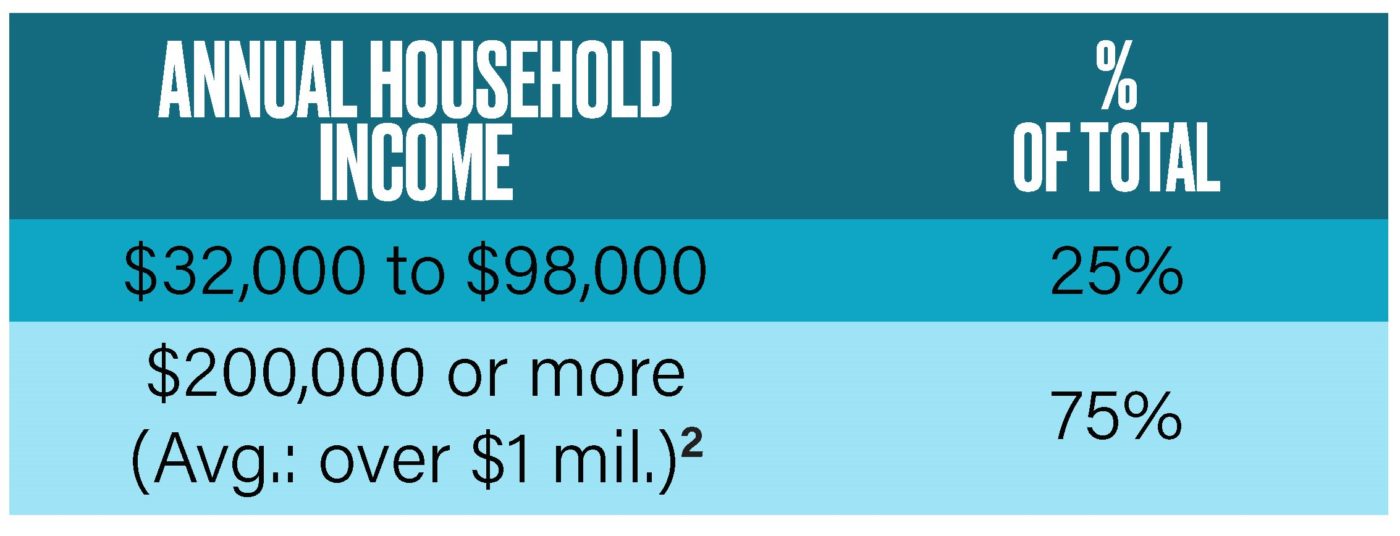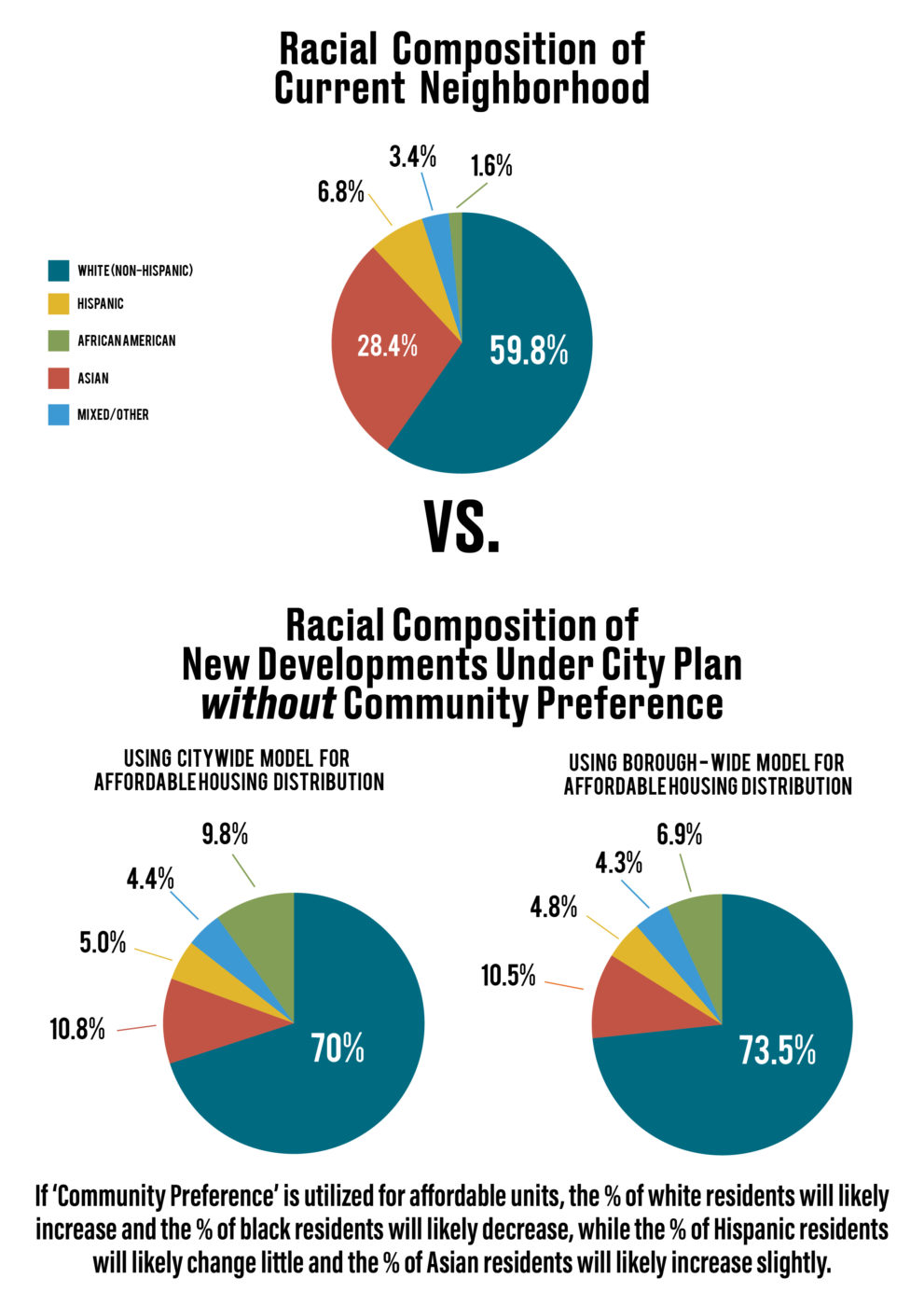Fighting the City’s SoHo/NoHo Rezoning Plan – By The Numbers
A newly-released study by Village Preservation shows that the City’s SoHo/NoHo Rezoning Plan will make both of these neighborhoods richer, whiter, and more expensive to live in than they are now, and likely create significantly less affordable housing than projected, potentially destroying more affordable housing than it creates.
In the fall of 2020, the de Blasio administration announced its plans to rezone the neighborhoods of SoHo and NoHo, saying it would “advance the City’s goals of fair housing and equitable growth” and “create a more inclusive…SoHo and NoHo” as part of “a more equitable and integrated city.” It would do so, they said by implementing “[t]houghtful, progressive zoning changes” which would ensure that “all neighborhoods… pull their weight to provide safe, affordable housing options.”
However, an analysis of the plan shows much the opposite. Even if the city’s projections prove correct, implementation of their upzoning plan will most certainly make these neighborhoods significantly less socio-economically diverse, with more expensive housing prices, than currently. While the neighborhood currently contains a considerable percentage of high income earners, it also contains a broad diversity of income levels, and a much larger share of lower-income earners, and many fewer high income earners than the developments the city’s upzoning would create.
Current composition of neighborhood (per 2014-18 American Community Survey for the 7 census tracts which overlap with rezoning area– all buildings are either within rezoning area or 1,000 ft. radius):

By comparison, new developments under the city’s plan would be considerably less socio-economically diverse, with vastly larger numbers of residents at the highest end of the socio-economic spectrum, and many fewer at the lower end.
Under the city’s plan, the composition of residents of new developments would be:

Currently nearly half the residents in the rezoning area make less than $100,000, whereas in the new developments under the city’s plan only 1/4 would. And of those 1/4 making less than $100,000, none would make less than approx. $32,000 annually, whereas currently almost 20% of residents do. Thus new developments will make SoHo and NoHo significantly less socio-economically diverse. To add to this, under the city’s plan, 75% of residents of new developments be very, very wealthy, even by the standards of these neighborhoods — they would likely own their home at prices costing on average $6.437 million (based upon our analysis of the average sale price for apartments in newly-constructed buildings in the area over the last 3 years), or pay extremely high market-rate rents for new construction. Currently, 23% of residents own their homes, with a median price of $1.539 million according to the city.

Under the city’s plan, just 25% of residents in new developments would necessarily be renters, paying between $567 and $2,161/mo., vs. currently 77% of area residents who are renters, with 46.8% of all residents (60.7% of all renters) paying rents below $2,499, and 37% of all residents (48% of all renters) paying rents below $1,999.

The city’s plan would also likely produce considerably less ‘affordable’ housing than projected. They claim their rezoning plan will create 330-498 units of affordable housing over the next ten years, as well as1,201-1,369 units of market rate housing.

In fact, the City’s housing and affordable housing projections are likely greatly inflated. Under the City’s plan, new development which is projected to be residential is at least if not more likely to end up being developed for commercial uses, with NO affordable housing, if it’s developed at all. A majority of the sites where they project housing being built will have zoning that will actually encourage commercial development rather than residential development.
79.4% of the projected residential units are to be built in areas where under the City Plan the zoning would allow a greater density of market rate commercial development (10 FAR) than market rate residential development (on average 9 FAR, depending upon MIH plan). Thus nearly 80% of the projected residential development in the City plan is likely to end up as commercial development, and those affordable housing units will never materialize.

Even on the minority (20.6%) of sites where the proposed zoning favors residential development, the differential is so small as to offer little assurance that residential development will take place (6.5 FAR for market rate commercial development with community facilities vs. on average 7.2 FAR for market rate residential development, depending upon version of MIH).
This makes the likelihood that developers will chose residential development rather than commercial development even on the remaining 1/5 of projected development sites relatively slim, depending upon the market.
Thus assuming that developers follow the zoning incentives under the City plan and build commercial when zoning allows larger market-rate commercial buildings, and residential when the zoning allows larger market-rate residential buildings, the number of affordable units which the rezoning will create would be only 68-103, rather than the 330-498 the city currently projects.

Additionally, many of the sites the city projects as residential development sites clearly will not materialize as such. At this site at 40 East 4th Street (r) at the Bowery, the city projects a residential development with 110 units, 27 of them affordable. In fact, plans have been filed for 21-story office building on the site with no housing, affordable or otherwise.
In addition to facing a plan which could result in very little ‘affordable’ housing being built, a reduction of socio-economically diverse renters/owners, and an increase in home prices, the racial diversity of the neighborhoods is also in danger. It’s like the city’s plan would increase the percentage of white residents of the neighborhood, and significantly decrease the percentage of Asian residents.
The current racial composition of the 7 census tracts for the rezoning area is:

While it is impossible to concretely predict the race of the new residents of the neighborhood under the city’s rezoning plan, it is possible to make projections based upon some clear indicators around income distribution. Assuming that the affordable units (25% of the building) reflect the citywide makeup of residents in their income bands, 37.25% of residents of those affordable units will be white, 11.3% will be Hispanic, 30.14% black, and 13.3% Asian. Combined with the market rate units, this will result in buildings which are 70% white, 10.8% Asian, 5% Hispanic and 9.8% black – a higher percentage white and black than the 7 census tracts for this neighborhood, but a lower percentage Hispanic and a dramatically lower percentage Asian. If one assumes residents of the ‘affordable’ component of new developments follow a pattern more typical for the demographics of Manhattan in those income bands (as opposed to the city as a whole), the lack of diversity as compared to the current neighborhood gets even starker. And if the city’s current system of requiring “community preference” for 1/2 of the residents in new affordable housing, meaning they must currently live within the local community board, the % of white residents of these new developments under the city plan would rise even higher, and the % of black residents would fall.


In addition to the pressure for direct displacement that the city’s planned upzoning will create, it will add significant pressure on directly adjacent areas, especially those to the east and north of the southeast ‘Housing Opportunity Zone’ which borders Chinatown. That adjacent area has an even higher concentration of Asian and lower-income residents. The census tract in which this area lies is majority Asian (64% as per the 2010 census), with Asian residents most highly concentrated in the southern section, closest to the proposed upzoning area.
Public records show 1,257 units of rent-regulated housing in this small area directly to the east and north of the proposed upzoning, bounded by Canal and Kenmare Streets and the Bowery. That high concentration of rent-regulated units, charging lower rents and predominantly housing Asian residents, will also be threatened by the proposed upzoning plan. All are within the approx. 1,000 ft. boundary of the proposed rezoning – the area typically considered subject to the study of the effects of a rezoning.
The city’s SoHo/NoHo upzoning plan will make these neighborhoods richer and whiter, make housing prices overall much more expensive than they are now, likely destroy a considerable amount of affordable housing, and create about 80% less affordable housing than projected. It will allow grossly out of scale development and a flood of super luxury condos at prices averaging over $6 million for households with incomes averaging over $1 million, as well as large new office buildings and big box chain stores. The city is ignoring the clear evidence of the impact which this plan would have, not just on SoHo and NoHo but adjacent neighborhoods like Chinatown and the Lower East Side, continuing a pattern of wildly inaccurate projections and prognostications about what their rezonings would do.
There are ways to make SoHo and NoHo more affordable and equitable, as well as to update nearly fifty year old zoning which in some cases may conflict with present-day realities. The city’s plan is not the way to do so. It will exacerbate problems of affordability and inequality in these neighborhoods, and in adjacent neighborhoods which will also be impacted. And it will destroy the qualities of the built environment, the artistic heritage, and the unique character of these neighborhoods which have made SoHo and NoHo successful and sought-after.
The Community Alternative Rezoning Plan, developed by a group of civic and community organizations, lays out a plan that would not destroy any affordable housing or push out any existing residents but would create as much if not more affordable housing than the city’s plan, especially if combined with direct subsidies for the construction of new affordable housing in the neighborhood.
Help us fight to promote and protect equitable, diverse, affordable neighborhoods that respect and preserve history and neighborhood character:
